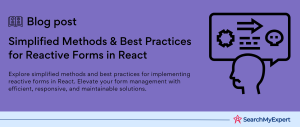Error Boundaries in React: A Safety Net for Your Applications
Harnessing Error Boundaries for Robust React Apps
In the dynamic world of React applications, error handling is not just a necessity; it’s an art. Error Boundaries in React are the art’s masterpiece, providing a sophisticated mechanism to gracefully handle errors in component trees, preventing the entire application from crashing due to a single, isolated error. This concept, akin to a safety net, ensures that even when a component fails, the rest of the application can continue to operate seamlessly.
What are Error Boundaries in React?
Error Boundaries in React are specialized components that catch JavaScript errors anywhere in their child component tree, log those errors, and display a fallback UI instead of the component tree that crashed. They act like catch blocks, but for React components, encapsulating the unpredictable nature of errors and offering a controlled response strategy.
The Problem They Solve: Cascading Errors and Crashing Applications
Before the introduction of Error Boundaries, a single error in one part of the UI could lead to a cascade of errors, eventually crashing the entire application. This all-or-nothing failure mode was far from ideal, making it difficult to ensure a smooth user experience. Error Boundaries address this issue head-on by localizing the impact of errors, preventing a single failure from becoming a full-scale application meltdown.
When Were They Introduced and Why Are They Important?
Error Boundaries were introduced in React 16, marking a significant milestone in React’s evolution. Their introduction was driven by the need for a more robust error-handling mechanism that could improve application resilience and maintainability. They are important because they:
- Improve User Experience:
By allowing applications to recover gracefully from errors and display a user-friendly error message or fallback UI. - Enhance Development Workflow:
Developers can isolate faults and maintain application stability during debugging. - Boost Application Resilience: They make React apps more resilient against unanticipated JavaScript errors, ensuring smoother runtime operations.
By incorporating Error Boundaries, developers empower their React applications to handle unexpected errors with elegance, maintaining the application’s integrity and ensuring a seamless user experience even in the face of errors. This introduction to Error Boundaries lays the foundation for understanding their pivotal role in crafting resilient and user-friendly React applications.
How Error Boundaries Work: The Technical Breakdown
Diving deeper into the mechanics of Error Boundaries in React reveals a sophisticated system designed to catch errors where they happen and manage them efficiently. This system is built on the foundation of React’s lifecycle methods and provides a structured approach to error handling within the component tree.
Catching Errors Within the Component Tree
Error Boundaries work by catching errors that occur during the rendering phase, in lifecycle methods, and in constructors of the whole tree below them. However, it’s important to note that they do not catch errors for:
- Event handlers
- Asynchronous code (e.g., setTimeout or requestAnimationFrame callbacks)
- Server-side rendering
- Errors thrown in the error boundary itself (rather than its children)
Lifecycle Methods Covered
Two specific lifecycle methods make the magic happen: static getDerivedStateFromError() and componentDidCatch().
- static getDerivedStateFromError(error): This lifecycle method is invoked after an error has been thrown by a descendant component. It receives the error as a parameter and returns a value to update state.
- componentDidCatch(error, info):
This method is called after an error has been caught by the error boundary. It receives two parameters: the error that was thrown and an object with information about the component that threw the error. This is where you can perform error reporting.
Visual Representation of an Error Boundary’s Scope
An Error Boundary effectively encapsulates its child components, offering a shield against uncaught JavaScript errors. When an error is thrown within its scope, the Error Boundary intercepts it, preventing the error from escalating and potentially crashing the application. Instead, it can render a fallback UI, log the error for developers, and maintain the rest of the application’s UI intact.
The scope of an Error Boundary is determined by where it is placed in the component hierarchy. Placing an Error Boundary high up in your app’s component tree can catch more errors; however, this may result in a larger portion of your app being replaced by a fallback UI in case of an error. Strategically placing Error Boundaries around high-risk components can offer a more nuanced error-handling strategy.
Implementing Error Boundaries in React: A Comprehensive Guide
Error Boundaries in React act as crucial safeguards, protecting applications from unexpected errors that can degrade the user experience. For developers aiming to enhance the resilience of their React applications, mastering the implementation of Error Boundaries is key. This guide explores the process of creating Error Boundary components, focusing on the distinctions between class and functional components, and sharing best practices for effective error handling.
The Role of Component Types in Error Boundaries
React’s architecture allows for two main types of components: class and functional. However, when it comes to Error Boundaries, there’s a significant limitation—only class components can be used to implement them. This restriction is due to the necessity of specific lifecycle methods that are exclusive to class components, such as componentDidCatch and getDerivedStateFromError. Despite the shift towards functional components in the React community, class components retain their value for their exclusive capability to host Error Boundaries.
Steps to Create an Error Boundary
Creating an Error Boundary involves utilizing class components to encapsulate other components, providing a safety net for catching errors. The process requires the implementation of at least one of two key lifecycle methods:
- The first method updates the component’s state to trigger a fallback UI when an error occurs.
- The second method allows for the logging of error details and the execution of side effects after an error is caught.
This dual-method approach ensures that errors within the component tree are managed effectively, preventing them from propagating and potentially crashing the entire application.
Best Practices for Error Handling and UI Rendering
When integrating Error Boundaries into your application, several best practices can enhance their effectiveness:
- Strategic Placement: Carefully position Error Boundaries around components that are likely to fail. This targeted approach allows for more meaningful fallback UIs and error messages, tailored to the context of the potential error.
- User-Friendly Fallback UIs:
Design fallback UIs that provide clear guidance to users, helping them navigate the error state effectively. - Error Logging:
Utilize Error Boundaries as an opportunity to log errors to a reporting service, facilitating quicker diagnosis and resolution. - Comprehensive Testing: Ensure the reliability of your Error Boundaries by testing them thoroughly, and simulating various error conditions to verify their effectiveness.
By adhering to these guidelines, developers can leverage Error Boundaries to build more robust and user-friendly React applications, ensuring that errors are handled gracefully and do not detract from the user experience.
Navigating the Limitations of Error Boundaries in React
Error Boundaries in React are a powerful feature for enhancing application resilience, but they’re not a panacea for all types of errors. Understanding the limitations of Error Boundaries is crucial for developers to effectively manage errors across various scenarios. This insight guides the use of alternative error-handling strategies where Error Boundaries fall short.
Understanding What Error Boundaries Don’t Catch
Error Boundaries are designed to catch errors in specific parts of the React component tree, but there are notable exceptions to their coverage:
- Event Handlers: Errors thrown in event handlers are not caught by Error Boundaries because these errors occur outside the rendering lifecycle methods that Error Boundaries monitor.
- Asynchronous Code: Errors that occur in asynchronous code, such as setTimeout or Promise chains, escape the catch mechanism of Error Boundaries.
- Server-side Rendering: Error Boundaries do not catch errors during server-side rendering processes. They are client-side error-handling mechanisms.
- Errors Within Themselves:
If an error occurs within an Error Boundary itself (for example, within its render method or a lifecycle method used for error handling), it cannot catch the error.
Alternative Error Handling Approaches
Given these limitations, developers must employ alternative strategies to ensure comprehensive error handling:
- Event Handlers: Wrap error-prone code in event handlers with try-catch blocks and manage errors locally or propagate them to a central error-handling mechanism.
- Asynchronous Code: Use try-catch blocks in async functions or .catch() in promises to handle errors in asynchronous operations. Consider adopting async error boundaries, a pattern that involves wrapping asynchronous operations in a component that can catch errors and render fallback UIs.
- Server-side Rendering: Implement error-handling mechanisms specific to your server-side framework. For Node.js, for example, uses middleware for catching and responding to errors.
- Errors Within Error Boundaries: Ensure robust testing of Error Boundaries to catch and fix any errors in their implementation. Consider using a higher-order component (HOC) or a wrapper component as an additional safety net for Error Boundaries themselves.
Strategically Leveraging Error Boundaries in React Applications
Error Boundaries in React offer a powerful mechanism for handling unexpected errors, but their effectiveness hinges on strategic implementation. Knowing when and where to use Error Boundaries can significantly enhance the resilience and user experience of your application. This section explores the nuances of deploying Error Boundaries for maximum impact, balancing granularity with maintainability, and focusing on critical components and user experience.
Strategic Placement for Maximum Impact
The placement of Error Boundaries within your React application is crucial. They should be strategically positioned around high-risk components and critical paths where errors are most likely to disrupt the user experience. Consider these guidelines for strategic placement:
- High-Risk Components: Components that interact with external APIs, perform complex calculations, or otherwise have a higher propensity for errors should be wrapped in Error Boundaries.
- User Flow Critical Paths: Parts of your application that are critical to the user journey, such as payment processes or user registration flows, should be protected by Error Boundaries to ensure smooth operation.
Balancing Granularity with Maintainability
While it might be tempting to wrap every component in an Error Boundary, this approach can lead to maintenance challenges and unnecessary complexity. Aim for a balanced strategy that considers both granularity and maintainability:
- Component Hierarchy Levels:
Place Error Boundaries at various levels of your component hierarchy to catch errors at different stages. Higher-level boundaries can catch errors in larger parts of your app, while lower-level boundaries protect individual components or small groups of components. - Maintainability: Ensure that your use of Error Boundaries does not complicate your application’s structure or make it difficult to maintain. The goal is to enhance stability without sacrificing code simplicity.
Prioritizing Critical Components and User Experience
Ultimately, the decision to use Error Boundaries should prioritize maintaining a seamless user experience, especially around critical components and functionalities:
- Critical Components:
Identify components that are essential to your application’s functionality. Ensuring these components are safeguarded by Error Boundaries can prevent minor errors from escalating into major disruptions. - User Experience:
Design fallback UIs within your Error Boundaries that provide clear, helpful feedback to users when errors occur. This can include guidance on how to proceed or the option to report the issue.
Advancing Error Boundary Use in React: Techniques for Enhanced Resilience
Error Boundaries in React are a foundational tool for error handling, but their utility can be significantly expanded through advanced techniques. These strategies involve leveraging Error Boundaries for more than just catching and displaying errors—they can be used for error logging, as a basis for higher-order components (HOCs), and in conjunction with third-party libraries to augment their functionality. Here’s how you can harness these techniques to fortify your React applications.
Logging and Reporting Errors for Debugging and Analysis
One of the primary benefits of using Error Boundaries is the ability to capture error information before the application crashes. This information can be invaluable for debugging and improving application resilience.
- Implementing Error Logging:
Within the componentDidCatch method, integrate error logging to capture both the error and the component stack trace. This information can then be reported to a logging service or error-tracking tool. - Analysis and Monitoring: Regularly review logged errors and monitor their frequency and severity. This analysis can help prioritize bug fixes and improvements in future development cycles.
Error Boundaries as Higher-Order Components (HOCs)
Error Boundaries can also be implemented as Higher-Order Components, a pattern that enhances component reusability and composability in React applications.
- Creating an HOC Error Boundary: Wrap your component logic within a higher-order component that includes Error Boundary logic. This HOC can then be reused across your application to wrap any component with Error Boundary protection.
- Flexibility and Reusability: By using HOCs, you can apply consistent error-handling logic across multiple components or parts of your application without duplicating code, enhancing maintainability.
Third-Party Libraries for Enhanced Error Boundary Functionality
Several third-party libraries have been developed to extend the capabilities of Error Boundaries, offering more sophisticated error-handling solutions.
- Library Integration: Libraries such as react-error-boundary provide additional hooks and utilities for working with Error Boundaries, making it easier to implement advanced features like reset functionality after an error has occurred.
- Enhanced Functionality:
These libraries often include features that go beyond the basic React Error Boundary API, such as the ability to reset component state after an error or more granular control over error handling behavior.
Mastering Error Handling in React: Embracing Error Boundaries for Superior Applications
The journey through the intricacies of Error Boundaries in React culminates in a richer understanding of their critical role in building resilient and user-friendly applications. This conclusion serves not only as a recap of the key benefits and use cases of Error Boundaries but also as a guide to embedding effective error-handling practices in your React projects. Looking ahead, we’ll touch on the horizon of future developments and evolving best practices in error handling within the React ecosystem.
Recap: The Power of Error Boundaries
Error Boundaries offer a specialized mechanism for catching and handling errors in React component trees, preventing entire applications from crashing due to isolated errors. They encapsulate the error-prone components, providing a safety net that allows the rest of the application to remain functional. The primary benefits include:
- Improved Application Stability:
By localizing the impact of errors, Error Boundaries enhance the overall stability of React applications. - Enhanced User Experience:
Offering fallback UIs in the event of component errors ensures that users are not faced with a completely broken application interface. - Simplified Error Management:
Error Boundaries centralize error handling in component trees, making it easier to manage and debug unexpected errors.
Tips for Effective Error Handling
To leverage Error Boundaries most effectively in your React applications, consider the following tips:
- Strategic Placement:
Implement Error Boundaries around components or component trees that are most susceptible to errors or are critical to the user journey. - Granular Implementation:
Balance the use of Error Boundaries to avoid unnecessary complexity, focusing on maintaining both granularity and maintainability. - Comprehensive Logging:
Use Error Boundaries as an opportunity to log detailed error information, facilitating easier debugging and improvement of application robustness.
Looking Ahead: Future Developments and Best Practices
The landscape of web development and React, in particular, is ever-evolving, with continuous improvements and updates aimed at enhancing developer experience and application performance. As we look to the future, the focus on error handling and application resilience is likely to yield new patterns, practices, and tools. Developers should stay attuned to:
- Evolving Error Handling Patterns:
Emerging patterns, such as enhanced support for asynchronous error handling or integration with concurrent features in React, may offer new ways to manage errors. - Community and Library Support: The React community and third-party libraries will continue to evolve, offering new utilities and hooks that simplify the implementation of sophisticated error-handling strategies.
- Best Practices:
As React evolves, so too will the best practices for error handling. Keeping abreast of developments in the ecosystem will ensure that your applications remain at the cutting edge of usability and stability.
Conclusion
Embracing Error Boundaries and effective error-handling practices is not just about preventing application crashes; it’s about building a foundation for applications that are as resilient as they are user-friendly. As you incorporate these strategies into your React applications, you’re not just coding for the present—you’re preparing for a future where robustness and elegance go hand in hand.
Empower your development team with React Development Service Companies.
Table of Contents
Toggle






